Everyone is talking about agile project management. Many project managers are expected to use agile methods nowadays – but does everyone know what these are? How do they differ from traditional project management methods?
How do the hybrid methods work? This article will shed some light on these methods, explain how they are used, and help you choose the right method for your needs.
We will address each of the following topics:
- Traditional project management methods
- Agile project management methods
- Traditional and agile project management: the goals
- MVP – Minimum Viable Product
- A clear distinction: traditional vs. agile roles and processes
- Hybrid project management – a mix of traditional and agile methods
- Sample software solution: Microsoft Project + Jira integration
- Key success factors for agile project management
- Conclusion and recommendations
Traditional Project Management Methods
A glance at the history of project management shows how and why traditional planning methods evolved as they did. Tools such as:
- Gantt charts to depict time intervals (developed in 1910)
- PERT & CPM for depicting interdependencies (developed in 1958)
as well as organizations such as:
- PMI and IPMA (founded in the 1960s)
- Axelos/Prince2 (founded in 1996)
were established in an era of large-scale projects of a longer duration. So, the project’s goals until completion were ‒ in theory at least ‒ clearly and carefully defined, and any change was costly. This meant that changes were considered to be disruptions. Everyone focused 100% on the goals.
Special Download: Agile, Traditional or Hybrid Project Management? (PDF file)
Please fill in the form.
* Required Fields | Data Protection
Traditional project management methods, therefore, offered numerous methods for control and management. Even today, these methods suffice for industries such as construction, plant engineering, pharmaceuticals, and many others.
Our tip: If you are planning a project in which the requirements are pretty clear right from the start and the work can be thoroughly planned, then the traditional PM approach is quite suitable. Even in environments with a high degree of statutory provisions or regulatory requirements, the traditional project management methods will prove to be sufficient.
Agile Project Management Methods
Agile methods are newer and originated in software development (greatly inspired by the concept of lean manufacturing). They are characterized by:
- They are well-suited for short duration projects
- There is a greater focus on the customer benefit than an overly rigid adherence to the goals
- They encourage flexibility in reaching the goals
- Changes are therefore welcomed if they provide useful improvements
- They are easy to use and have fewer guidelines than many traditional methods
- They rely on teams to self-organize themselves, which demands great trust
Finally, the Agile Manifesto of 2001 clearly states that:
- Agile Manifesto 2001
- – Individuals and interactions over processes and tools
– Working software over comprehensive documentation
– Customer collaboration over contract negotiation
– Responding to change over following a plan.
In 2001, 17 renowned software developers issued the Agile Manifesto (“Manifesto for Agile Software Development” or “Agile Manifesto”). This group of developers included people such as Jeff Sutherland and Ken Schwaber, formulators of the Scrum framework. Today, the manifesto serves as an important pillar of the agile movement.
The agile principles listed in the manifesto all focus on the importance of interaction. Their objective is to move away from rigid processes bureaucracy.
Scrum: The Most Widely Used Agile Method
Scrum uses a Product Backlog along with user stories instead of detailed product specifications. These user stories describe user wants from their perspective. Also, the product backlog is incrementally enhanced during the development process, making it a “living” artifact.
The work to be done during a sprint is planned together with the stakeholders at the beginning of that particular Sprint. After that, the development team meets in a Daily Scrum to plan the work that needs to be done.
Ever heard about Agile PMOs? Find more detail here.
When a sprint ends, there is a review:
- The work results are presented to the stakeholders in a sprint review.
- After the review, the team organizes and holds an internal sprint retrospective. This is part of their self-management.
- In the retrospective, the team evaluates its methods and processes, as well as how well the team itself functioned as an entity. If improvements are necessary, then actions to be taken in subsequent iterations are discussed and decided upon.
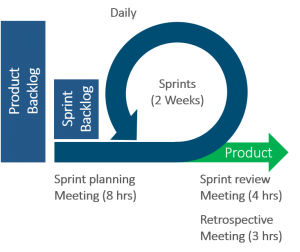
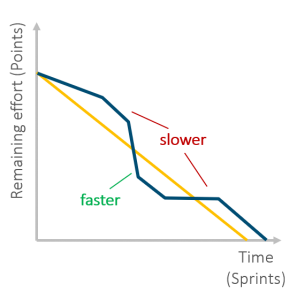
In addition to this pure form of Scrum, there are also variations such as Reliable Scrum (with critical chain elements), and other agile tools. These include: Kanban boards in which there are no roles because these only serve to help visualize the work processes.
Our tip: Does your endeavor involve a project in which – at the start – the requirements are not yet really clear, the objectives are somewhat flexible, and for which short planning horizons are an option? If so, agile project management methods could be suitable for you. Scrum, especially, could be the right choice if you want to achieve the objectives rather quickly and flexibly. Having a Scrum Master can help you with the process of implementing rules and establishing a fixed sprint cadence for you and your stakeholders.
Traditional and Agile Project Management: The Goals
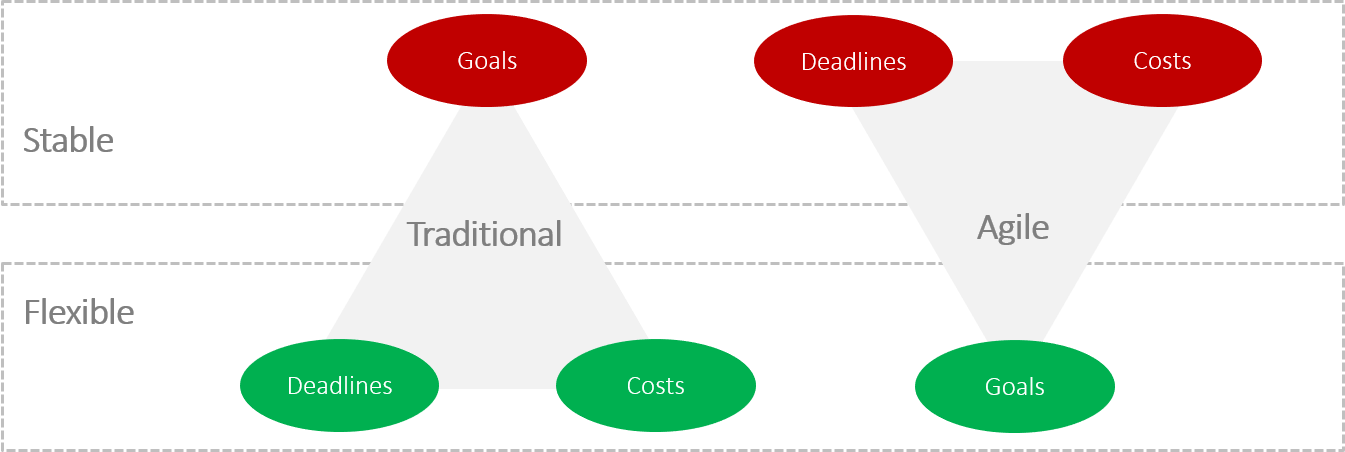
In the traditional approach the concept and the specifications derived from it, provide the basis for the implementation. In the end, what counts is the acceptance and use of the overall result produced.
Agile project management, on the other hand, focuses instead on the product version. A customer can see and evaluate one of the initial versions of a product and give their feedback. You can then use this feedback to modify the original plan and, through regular contact with the customer, develop the subsequent versions.
This means that: The closer you collaborate with the customer, the better and more usable the result of your efforts will be.
In the end, the risk of unpleasant surprises is significantly lower than for methods involving long-term pre-planning. Each iteration of the product comes one step closer to meeting the customer’s needs, thereby enhancing the benefit to the customer.
Our tip: Begin by talking to your stakeholders and explaining to them that agile project management methods demand closer cooperation with the customer to work well. Ensure that you and your team understand that these methods demand an openness to new ways of working. Explain that it is completely normal that implementing these processes takes a bit of time and that the maturity level of Scrum teams only increases with experience.
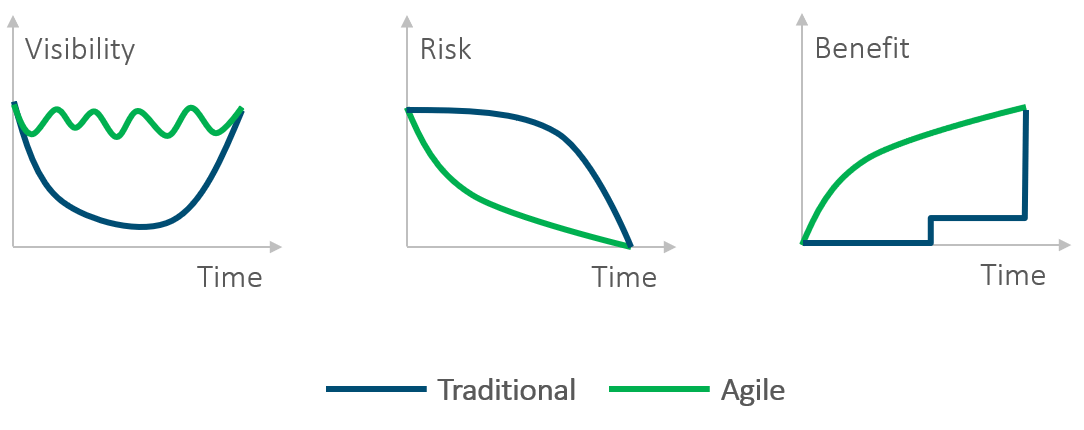
When trying to decide between project management methods, ask yourself this question: can I afford to have flexible goals?
Of course, a product must also be able to be divided into individual usable components. This is more difficult in a construction project than in software development because in construction the individual parts are useless without the overall result.
Learn more about Program Management Solutions in Product Development and R&D.
MVP – Minimum Viable Product
The concept of a Minimum Viable Product or MVP is based on this premise: if the first prototype of the desired product that you deliver to the customer is not yet especially beautiful or does not have all the functions requested, but can still provide a benefit to the stakeholder ‒ this is the MVP. The use of this early version, in turn, provides you with valuable feedback that is helpful in further optimizing the final product.
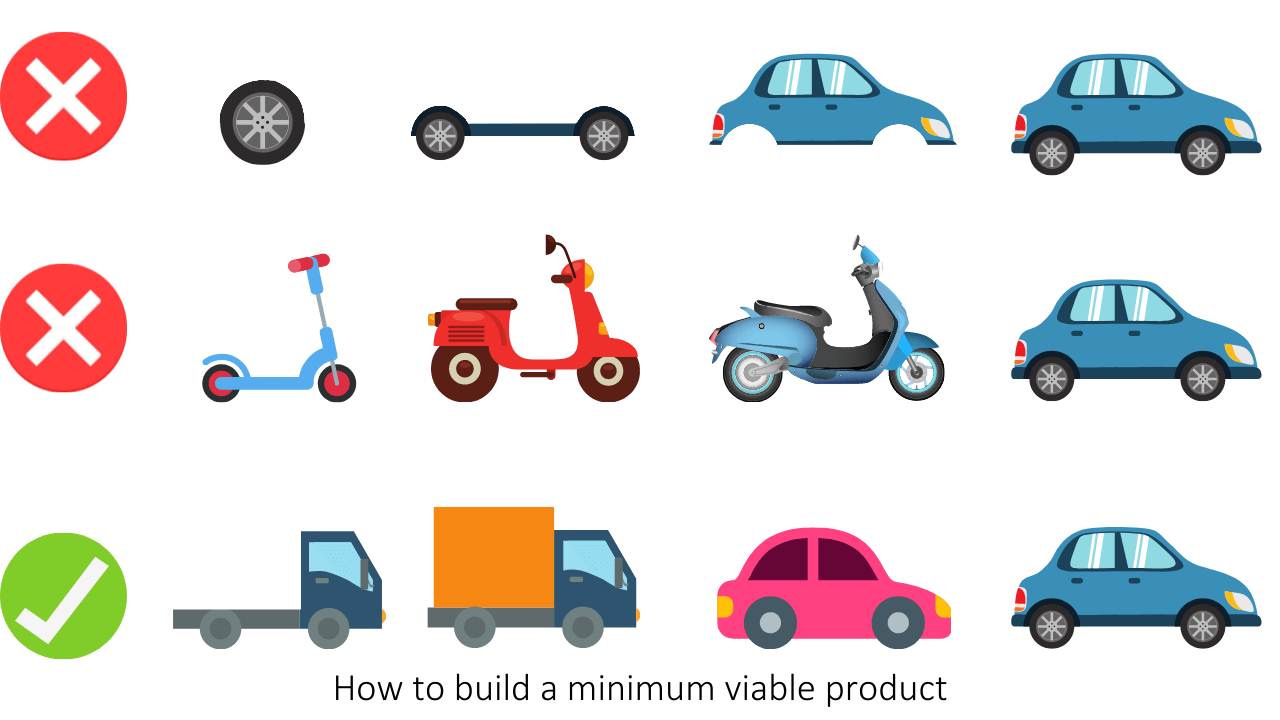
Subscribe to the TPG Blog Newsletter now and never miss another blog post.
A Clear Distinction: Traditional vs. Agile Roles and Processes
In traditional project management, there are roles such as:
- Project sponsor
- Requests the project
- Steering committee member
- Makes decisions as necessary
- Project manager
- Deals with the stakeholders
- Plans and manages
- Reports and communicates
- Team member
- Responsible for completing work packages
- Develops the deliverables
- Time completion confirmation
Each of these has clear responsibilities. In Scrum, there are three key roles:
- Product Owner
- Single source of requirements
- Manages and prioritizes the backlog
- Communicates with the stakeholders
- Scrum Master
- Leads the Scrum process
- Ensures that team is prepared for the process
- Removes impediments
- Team
- Evaluates the backlog items
- Allocates tasks among the team members
- Reports when DONE
- Gives feedback in reviews and retrospectives
The Product Owner is the person responsible for the product requirements and the one who represents the stakeholder.
Scrum Masters ensure that the Scrum process is implemented. They support the team and remove any obstacles.
Note: Scrum Masters can also obtain certification to help them more fully comprehend the theory and support their work. A Scrum Master certification is viewed as the first building block of Scrum training. It can also be useful for other Scrum team members.
As the third role in Scrum, the development team bears much responsibility, as it:
- Estimates the required effort
- Chooses its tasks based on these estimates
- Informs others when these tasks have been accomplished (as per the agreed Definition of Done)
Important feedback in reviews and retrospectives comes not just from the stakeholders but also from the team itself in agile project management environments.
The roles are clearly defined when using Scrum methods. However, Scrum handles project responsibility differently (than traditional project management does).
Our tip: Read the Scrum Guide to learn more about the roles before employees take on these roles. Your team members can, of course, retain their existing job titles while acting in a different Scrum role.
Free Download: How to Manage Tactical Resource Management (eBook)
How you make resource coordination between project and line management work smoothly: lots of practical tips and checklists on how to set this up quickly yourself (Processes & Tools).
Communication in Traditional and Agile Environments
Good communication is imperative when the people in these roles interact. In traditional environments, this communication is often in the form of status reports. The following kinds of meetings may be held:
- Kickoff at the start
- Planning meetings and status meetings during the project’s lifecycle, concluding with a Lessons Learned meeting at the end.
The meetings described in the Scrum Guide revolve around the idea that you should reduce the number of meetings to the absolute minimum necessary. These aforementioned meetings are intended to cover most of the topics necessary:
- Daily
- Planning
- Review
- Retrospective
If stakeholders insist on receiving formal reports, you can – at least theoretically – alert them to the Scrum Boards and other sources of information or invite them to attend a review meeting.
The Sprint Backlog clearly indicates what the team members are currently working on. Reviews can also include product demonstrations to help answer any questions.
There is further information on hybrid project management in this article.
Resource Management in an Agile Environment
Regardless of the methods used, it is essential for the company to have a well-planned concept for resource management for project portfolios. This requires a centralized database which, due to its complexity, can only be coordinated by a Project Management Office (PMO).
Agile methods use fixed product / project teams. This greatly simplifies project resource management.
However, this is insufficient at the project management level. Regardless of whether you are using agile or traditional project management methods, you will need to determine the actual availability, absences, and operations.
Because resources are assigned to individual tasks in traditional projects, the differing deadlines make it difficult for people to switch from one project to another. In some situations, this can have a negative impact on productivity (see first graphic below).
It is much easier for an employee to switch from one project to another if the team membership remains constant for at least the duration of one sprint. It is a good idea to align the sprint lengths and cadence among several projects. That way, resources can be shifted at the end of a sprint (see second graphic below).
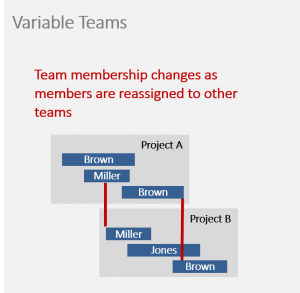
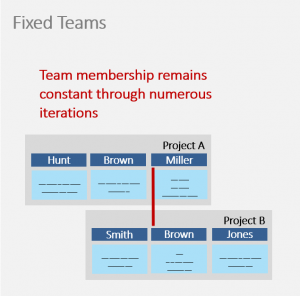
Our tip: Try to maintain the same cadence in all your projects to that team members can transfer from one project to another smoothly if need be.
Hybrid Project Management – A Mix of Traditional and Agile Methods
Hybrid project management is basically a combination of the previously described methods. Various combinations are possible, and here are just four examples of hybrid models:
- The design and specification are agile, but the implementation is traditional
- The design and specification are traditional, and the hardware implementation is traditional, but the software implementation is agile. (Here it is important to keep in mind the interdependencies.)
- The design, specification, and implementation of the hardware and software are traditional, the integration is agile.
- The design, specification, implementation and acceptance test are traditional but occur in planned periodic iterations. This is therefore not a combination of traditional and agile, but rather a combination of traditional and iterative. Please keep in mind that a harmonized cadence generally helps everyone involved.
Sample Software Solution: Microsoft Project + Jira Integration
How can you integrate all these suggestions in the software?
If, in the agile project, the project manager uses Microsoft Project and the employees track their tasks using Atlassian Jira, an MS Project Jira Integration makes sense.
The sharing of data between the two integrated systems turns:
- Phases into Versions
- Work packages into Epics
The Microsoft Project Epics are precisely planned as issues in Jira, and the effort is supplemented by, for example, Story Points. The combined story points are transferred, per Epic, back to Microsoft Project. This gives the project manager clarity when planning and later monitoring the completion.
By the way, it is also possible to synchronize the actual hours reported with the status information for the work packages in this way.
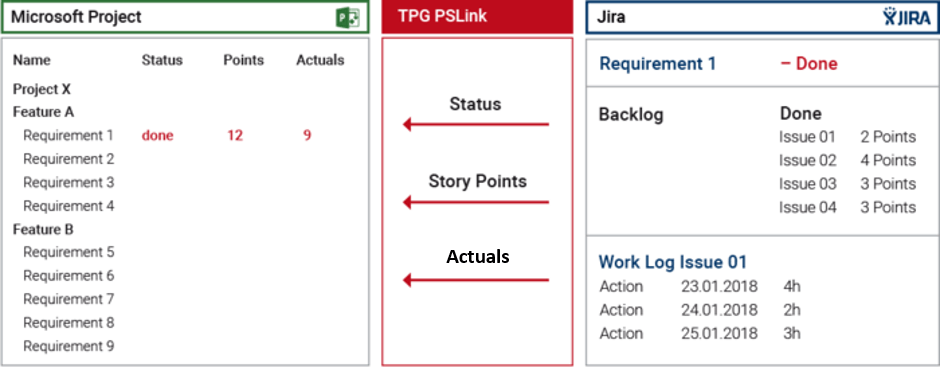
The integration of MS Project with Jira is only one example of how you can use the selected methods to track and manage complex project plans in software.
Our tip: There are ways to integrate trusted, familiar programs. Instead of migrating from one software environment to another, you should consider the use of an integration middleware solution. This would enable everyone to continue using the tool that is most familiar and best suited to their needs – while at the same time producing better data for the decision-makers.
Key Success Factors for Agile Project Management (a Selection)
When considering agile project management methods, keep in mind these important points:
- Your company’s PMO needs expertise in the methods: It should be able to distinguish between the traditional and agile methods and be able to choose the right processes based on the situation.
- Your company needs a system that overall best suits your requirements. Your stakeholders should commit to using the chosen processes.
- Reliable planning – even with agile methods – requires that you include the estimated tasks in a Sprint. Your Product Owner should prioritize the tasks beforehand correspondingly.
- The autonomous manner in which agile teams operate can also lead to surprises. You should be aware of this and be able to take action to mitigate the effects if necessary.
- The first step in implementing agile project management is to establish a uniform cadence in your timing. You can begin using the agile methods in a second step.
Conclusion and Recommendations
This article has explained why agile project management methods are so in demand these days. You now know the difference to traditional and hybrid planning methods.
The article provided insights into which method is most suitable for a given situation:
- Traditional project management is best when projects can be planned in advance and the requirements are relatively clear from the beginning. Change requests can be handled if there is a good change management process for dealing with them. This method is also well-suited for project environments that are subject to strong laws or highly regulated.
- Agile project management is best in situations where many details are still unclear at the project’s beginning. Here, the details are developed step by step together with the customer in an iterative process as the project progresses.
- The hybrid approach is recommended in situations where the project is easy to divide into sub-projects that can be reliably planned.
To summarize: There is no “one right method” that is suitable for every project. You need to choose the method best suited to the particular project.
Our final tips
Get to know the individually adaptable “PPM Paradise” – the optimal environment for your enterprise-wide project, program, portfolio and resource management. Download the eBook now (just click, no form).
And sign up for our bi-weekly blog newsletter to make sure you receive all our updates.
What has been your experience with the different project management methods? Please let us know in the comment area below. We look forward to your feedback!
Subscribe to TPG BlogInfo: Never miss new practice-oriented tips & tricks
Every other week: Receive practical tips in TPG blog posts written by recognized experts in project, portfolio, and resource management.
* Required Fields | Data Protection
About the author: Johann Strasser, a certified engineer, has been a managing partner at TPG The Project Group since 2001. After many years as a development engineer in the automotive and energy sectors, Johann Strasser spent a decade as an independent trainer and consultant in the field of project management. During his tenure, he also served as project manager for software projects in the construction industry and provided scheduling and cost management support for large-scale construction projects. At TPG, he applies his expertise in product development and consulting services for international clients. His special focus is on PMO, project portfolios, hybrid project management, and resource management. For many years now, he has shared his knowledge through presentations, seminars, articles, and webinars.
You can read more about Johann Strasser on LinkedIn and XING.








